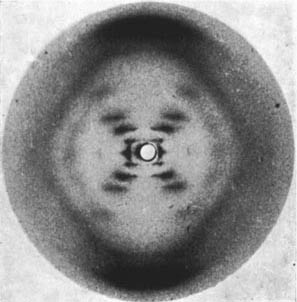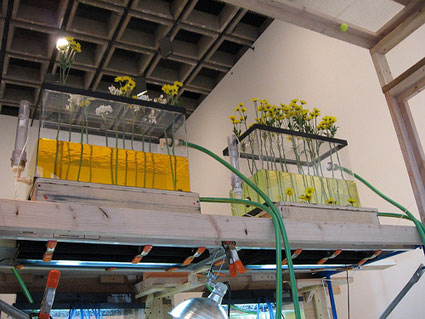The most interesting part of the article was at the end. Rubin says we see birds "as microcosms of ourselves who seemingly have greater access than we do to some of the nooks and crannies of our universe." This statement can be broadened to cover not just birds, but much of the flora and fauna that surrounds us. We see nature as a way to access and explain our desires (like the desire to fly) and to define our role as earthly creatures.
Here are some of the works I could find that prompted me to think deeper about the metaphoric potential of animals:
*note that these artists were all a part of the exhibition Birdspace: A Post-Audubon Artists' Aviary but the specific works below aren't the ones that were shown.
Thomas Woodruff

Root Hare, Thomas Woodruff
In the paintings from Thomas Woodruff's series Freak Parade terrestrial animal and plant forms are mutated into mythic still lives. Giraffe necked bunnies - half macabre, half romantic - use their new found extension to reach food that no longer grows out of the earth but instead swings from a tree's highest branches. These highly evolved rabbits have replaced their less fit root species by reaching higher and further for their carrots, undoubtedly a metaphor for capitalism.

Thomas Woodruff, A Vulgar Display
Woodruff's paintings mimic a bell jar shape, reinforcing their metaphoric charm as scientific curiosities and microcosms of life contained and miniaturized. Similar to Root Hare, A Vulgar Display seems like a miniature universe unto itself. Bug like creatures zip around a strange sprouting growth on their carrot cars (maybe they have hood ornaments? The jpeg is too small to tell.) This portable island of capitalist accumulation is propped up on ice skates and celebrating its mobility with fireworks and carrots on top.
Carlee Fernandez

Carlee Fernandez, Lola Isern
Carlee Fernandez creates her sculptural works by integrating common household items (like a laundry basket) into taxidermied animals (like the goat above). Goats are among the oldest domesticated animals and many people still rely on them for food and labor. Fernandez's piece plays on the forgotten value of animals in our modern lifestyles. While the need for a goat may not be apparent to the average American, imagine if that goat carried your laundry up the stairs. (please, please, please God send me one!) As tasks once preformed by domesticated work animals cease to exist and wilderness is scaled back further and further, will animals need to develop evolutionary traits that serve humans in order to aviod becoming extinct? I think Fernadez's goat is a humorously absurd look at that possibility.

Carlee Fernadez, Rat with Grapes
In later works, Fernadez begins to integrate fake natural objects into the sculptures, like plastic grapes. In this piece, a scavenger becomes a fruit bearer. Could this cross breed change the way Chicagoans see their alley neighbors? Will all animals some day have to appeal to humans or face extinction? Perhaps we will learn to graft fruit onto the back end of a rat just like we graft branches on fruit trees. What would a world filled with the animals of human desire and genetic imagination look like?
Julia Montilla

Julia Montilla, What Ails Us- The 100 Most-Prescribed Pharmaceuticals in the Nation
I am not exactly sure which diseases or pharmaceuticals Julia Montilla is representing with these guinea pigs, but I am grossed out. Remember that friend you had with the mom who kept fifty guinea pigs in one foot square cages in her basement and never cleaned them? This is the aftermath of that and it is spreading to humans. Horrifying and yet I knew it was bound to happen.
Actually, Montilla is probably referencing our tendency to use a "guinea pig" in place of a human for pharmaceutical testing. When we test the effects of medications, medical instruments and diseases on animals, we simultaneously confirm how close our biological makeup is to other animals while firmly establishing humans at the top of a hierarchical value system that determines which types of life are the most important. While guinea pigs are expendable, many American's feel that embryonic stem cells are morally sacred and can not be used in scientific testing.
A Bird Tapestry reminded me of a great article in the New York Times by Jonathan Rosen about Richard Barnes' photographs of starling bird flocks over Rome. (link)
Starlings are admired for their beauty and often kept as song birds and muses. They were released into the wild in the US because of these charms but have come to dominate huge parts of the sky and roost in unwanted places. In the piece Rosen says:
When humans contemplate animals, the question is always who is imitating whom. The starlings that so plague us in America (where we kill more than a million of the birds a year) grew out of our desire for nature to be poetic, rather than truly wild; they reflect the consequences of such self-serving fantasies. It isn’t their fault that they treated an open continent much as we ourselves did.
Who is imitating whom? Perhaps manifest destiny isn't only in our nature. As much as we would like it to, the wild does not yet arrange itself around our needs and fantasies.


Richard Barnes from the series Murmur
Below is a visual map of ways starlings may seem charming as individuals but foreboding as a flock.


As genetics and wild systems become more and more manipulated through science and technology, could we see new animals that seem desirable, much like the starling did, but end up having not just inconvenient but devastating effects on our survival? What consequences might emerge as animals move from continent to continent on shipping boats and in suitcases? Are humans equipped to decide which animals, plants and ecosystems should be preserved and which should be eradicated? I'm guessing the answer is no but I doubt much can stop us from finding out.
On a side note, Italian Greyhounds have been molded into tiny bundles of adorable. :)





.jpg/250px-Philip_Henry_Gosse_-_British_Sea-Anemone_and_Corals_(Plate_V).jpg)









